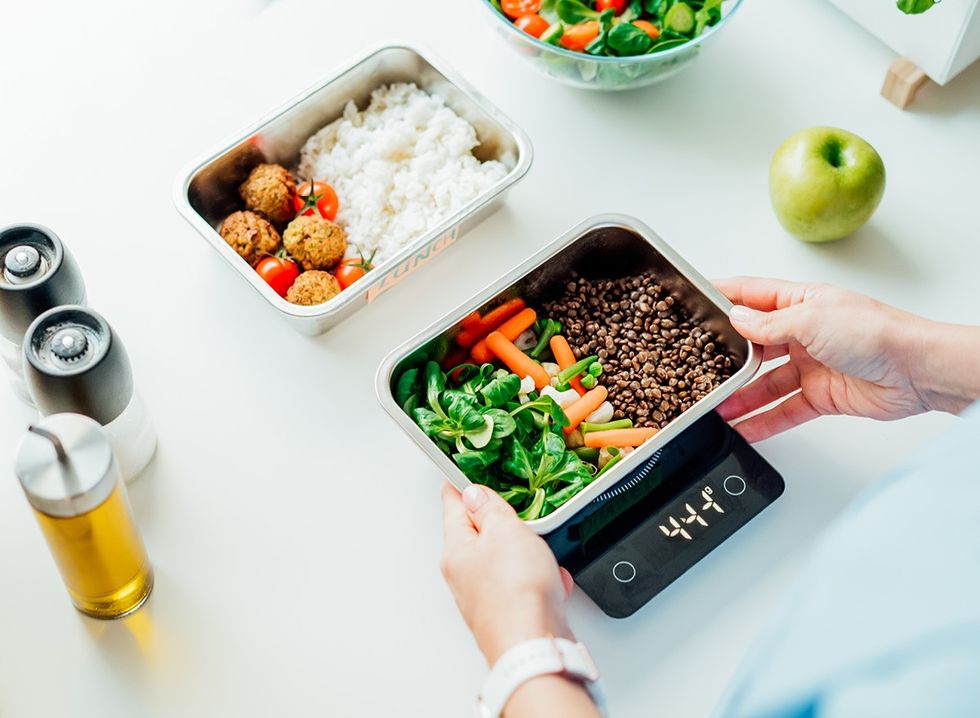Have you ever felt overwhelmed by complex workout routines or strict diets? Jessica, known as @itswellnessjess on social media, found a surprisingly simple solution to her weight loss journey: walking. Having lost over 70 pounds so far, Jessica's story is a testament to the power of consistent, low-impact exercise. We've also included insights from Matthew Stults-Kolehmainen, PhD, FACSM, an Exercise Physiologist at Yale New Haven Hospital. If you're seeking inspiration and practical tips to kickstart a simple exercise routine and shed some pounds, dive in now and start your journey.
Set a Daily Step Goal
Jessica emphasizes the importance of setting a daily step goal. "I have walked over 10,000 steps every single day this year," she says in her post. While 10,000 steps are her minimum, Jessica often surpasses this, hitting around 15,000 steps most days. She suggests that once you find a strategy that works for you, it becomes easier and more routine. For those feeling ambitious, Jessica recommends aiming for 15,000 steps per day.
Make Walking Enjoyable
One of Jessica's key strategies is to make walking enjoyable. "My favorite walking activity is to set up my walking pad on my standing desk and watch tiny desk performances or my favorite concert creators," she explains. By combining walking with activities she enjoys, Jessica finds that time flies by, and she's able to swap sedentary TV-watching time for active stepping time.
RELATED: I'm a Nutritionist and Here are 5 Reasons Why I Prescribe 30-Minute Walks for Weight Loss
The Importance of Enjoyable Exercise
Dr. Stults-Kolehmainen echoes Jessica's approach, stressing the importance of finding enjoyable forms of exercise. He states, "Humans naturally avoid things that hurt. That's why a lot of people don't like exercise. They learned that exercise is supposed to hurt. But we've had a whole different perspective on this and now we think exercise should be enjoyable. If you find something you find interesting, you're more likely to stick with it."
Use a Walking Pad for Convenience
Jessica invested in a walking pad, which allows her to walk indoors while multitasking. "I love to set up my walking pad on my standing desk," she says. This setup enables her to walk while working from home, watching TV, or even taking phone calls. For those without a walking pad, Jessica suggests pacing around your home during phone conversations to increase step count.
Track Your Steps
To stay accountable, Jessica recommends using a step-tracking device. "I am an Apple Watch girly," she shares, but also mentions more economical options like Fitbits or even smartphone apps like Google Fit for Android users. Tracking steps helps ensure you're meeting your daily goals and can motivate you to push further.
Understand the Math Behind Weight Loss
Jessica breaks down the math of her weight loss: "Just by adding the walking in that first month and a half, you would drop seven pounds if you didn't even really change your diet." She explains that by walking at a moderate pace for two hours a day (split into morning and evening sessions), you can burn an extra 538 calories daily. Over six weeks, this alone could lead to a loss of about 7 pounds.
RELATED: 5 Things This Health Coach Quit Doing to Beat Binge Eating and Transform Her Body
The Reality of Walking and Weight Loss
While Jessica's experience is inspiring, Dr. Stults-Kolehmainen provides a more cautious perspective. He explains, "To lose weight, you would need to double [the recommended 30 minutes of moderate to vigorous walking five days a week]." He emphasizes that while walking contributes to the 'calories out' part of the weight loss equation, it's unlikely to lead to significant weight loss on its own.
Combine Walking with Calorie Reduction
For optimal results, Jessica suggests combining increased walking with a moderate reduction in calorie intake. "We're not going on a super low calorie diet," she clarifies. Instead, she recommends reducing daily calorie intake by about 500 calories. Using her own stats as an example, Jessica calculates that this approach could lead to a loss of about 13.4 pounds in six weeks.
The Need for a Comprehensive Approach
Dr. Stults-Kolehmainen supports a more holistic approach to fitness. He states, "A comprehensive fitness program is key." However, he acknowledges the appeal of walking, noting, "a lot of patients like to focus on walking and they're successful with it because it's so simple. Just put on a pair of shoes and go outside."
Be Consistent and Patient
Jessica's success comes from consistency. "This is the first time ever that I have consistently done this," she says, referring to her daily walking routine. She emphasizes that while weight loss isn't always linear, consistent effort can lead to extended periods of steady progress. Jessica encourages others to stick with their walking routine, even on days when motivation might be low.
RELATED: 7 Tricks to Flatten Your Tummy Without Surgery According to a Plastic Surgeon
Walking is Underrated Cardio
Jessica believes that walking is often overlooked as a form of exercise. "The girls are sleeping on walking," she says. "Walking is one of the most underrated forms of cardio ever." She highlights that walking is accessible to everyone, regardless of fitness level or age.
Walking Doesn't Spike Hunger Hormones
One advantage of walking over high-intensity workouts is its effect on hunger hormones. Jessica explains, "There are studies that show that walking does not spike those hormones the way that higher intensity cardio workouts do." This can make it easier to maintain a calorie deficit and stick to your weight loss goals.
Multitask While Walking
Jessica emphasizes the versatility of walking. "You can get some stuff done while you're walking," she says. Whether it's taking work calls, catching up with friends, or watching your favorite shows, walking allows you to be productive while burning calories.
RELATED: I'm a Personal Trainer: 14 Pilates Moves That Helped My 50+ Clients Lose Weight
Start Slow and Build Up
For those just starting out, Jessica advises a gradual approach. "If you're someone who is trying to lose a significant amount of body fat, I don't think it's a good idea to dive into all this HIIT stuff, high impact," she cautions. Walking is a low-impact alternative that's easier on your joints and more sustainable in the long run.
The Power of 'Exercise Snacks'
Dr. Stults-Kolehmainen encourages starting with manageable goals, introducing the concept of 'exercise snacks'. He suggests, "If you're able to do what we call a little 'exercise snack,' let's say two to three minutes of walking, that's great. Get your exercise snack in. It's still better than nothing."
RELATED: I’m a Nutritionist and Here Are 4 Fall Comfort Foods That Can Help You Lose Weight
My 30-Pound Weight Loss Journey
Jessica's personal experience is a testament to the power of consistent walking. "I have lost so far over 30 pounds this year, and I probably would've lost a lot more if I would've cut my caloric intake down just a smidge, just about a couple hundred," she shares. Jessica emphasizes that this weight loss occurred over the first six months of her journey, demonstrating the effectiveness of her approach.
She adds, "I am still consistently on a downward trajectory and I know that I'm still on a downward trajectory. I can tell looking in my body, and it's just so exciting because this is the first time, this is the first time ever that I have consistently done like this."
Her success story provides tangible proof that a simple, sustainable walking routine combined with mindful eating can lead to significant weight loss over time. And if you enjoyed this article, don't miss 12-3-30 Walking Method: 20 Proven Tips to Lose Weight Faster.














 Shutterstock
Shutterstock Shutterstock
Shutterstock Shutterstock
Shutterstock Shutterstock
Shutterstock





 I'm a Nutritionist and These 9 High-Protein Snacks Keep My Clients Full While Losing 50 Pounds
I'm a Nutritionist and These 9 High-Protein Snacks Keep My Clients Full While Losing 50 Pounds
 Shutterstock
Shutterstock 2. Processed FoodsShutterstock
2. Processed FoodsShutterstock Shutterstock
Shutterstock Shutterstock/Prostock-studio
Shutterstock/Prostock-studio Shutterstock
Shutterstock Pro TipsShutterstock
Pro TipsShutterstock Shutterstock
Shutterstock Shutterstock
Shutterstock Shutterstock
Shutterstock Shutterstock
Shutterstock Don’t Drink as Much AlcoholShutterstock
Don’t Drink as Much AlcoholShutterstock Most Women on GLP-1s Are Making a Few Common MistakesShutterstock
Most Women on GLP-1s Are Making a Few Common MistakesShutterstock Soda and Sugary DrinksShutterstock
Soda and Sugary DrinksShutterstock Shutterstock
Shutterstock Eat BreakfastShutterstock
Eat BreakfastShutterstock And Improve Insulin SensitivityShutterstock
And Improve Insulin SensitivityShutterstock Belly Flab Strip Tip: Sugar and Fat Calories Leave Its Mark on Your BodyShutterstock
Belly Flab Strip Tip: Sugar and Fat Calories Leave Its Mark on Your BodyShutterstock Shutterstock
Shutterstock The Drugs Mimic the GLP-1 Hormone Naturally Produced by the BodyShutterstock
The Drugs Mimic the GLP-1 Hormone Naturally Produced by the BodyShutterstock 3. Deep-Fried ItemsShutterstock
3. Deep-Fried ItemsShutterstock